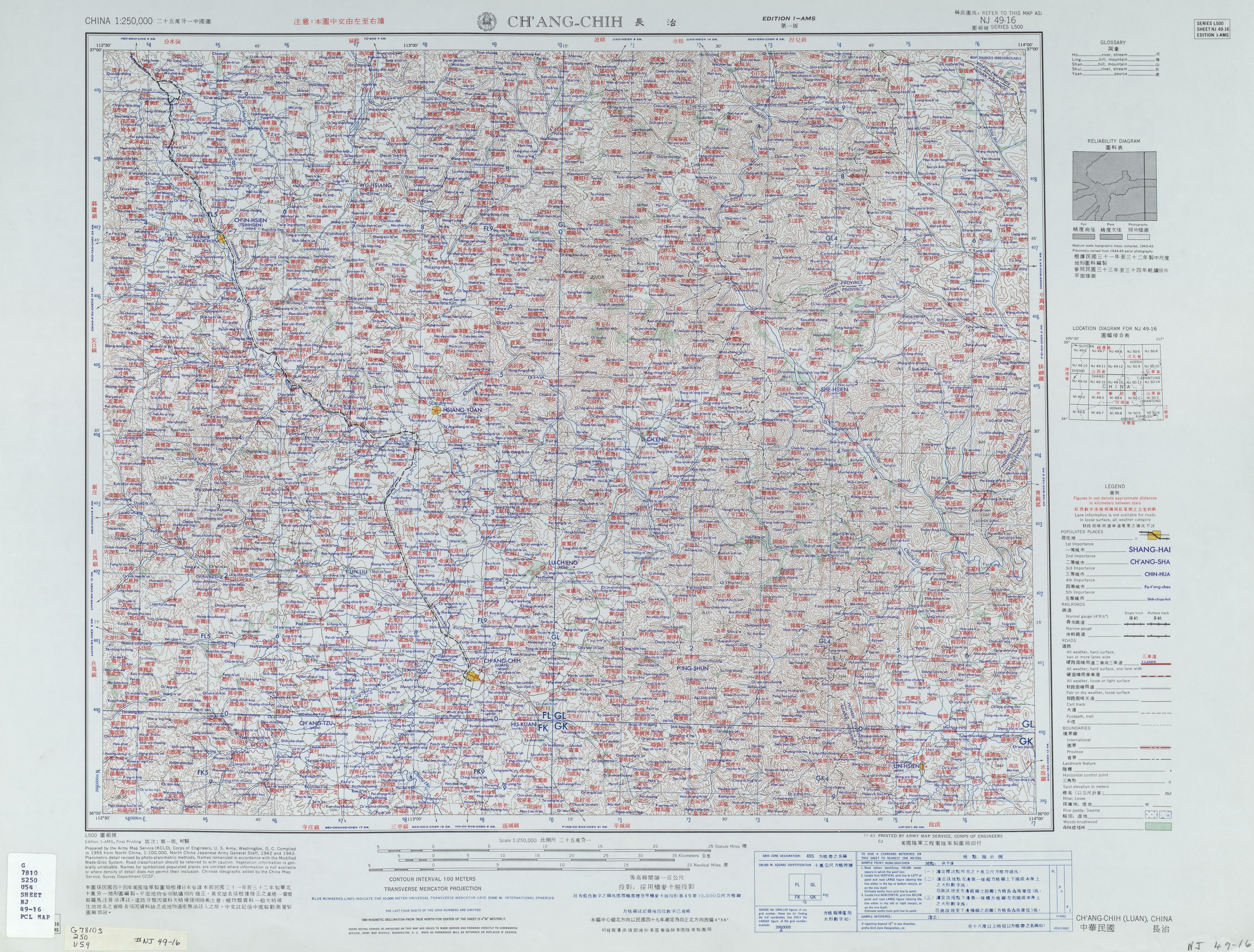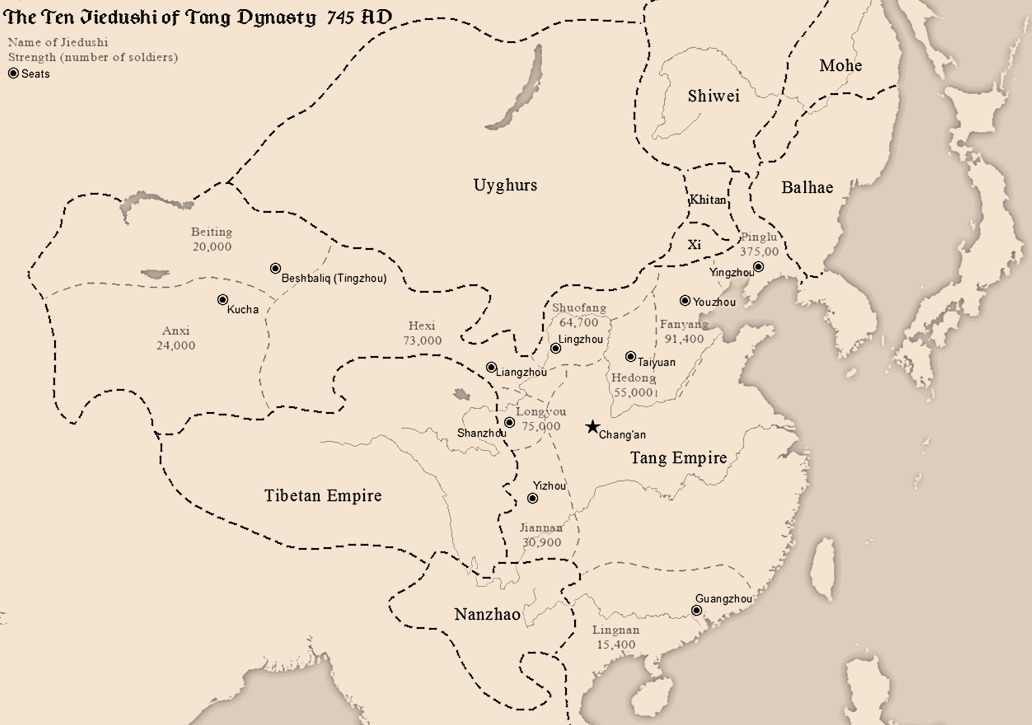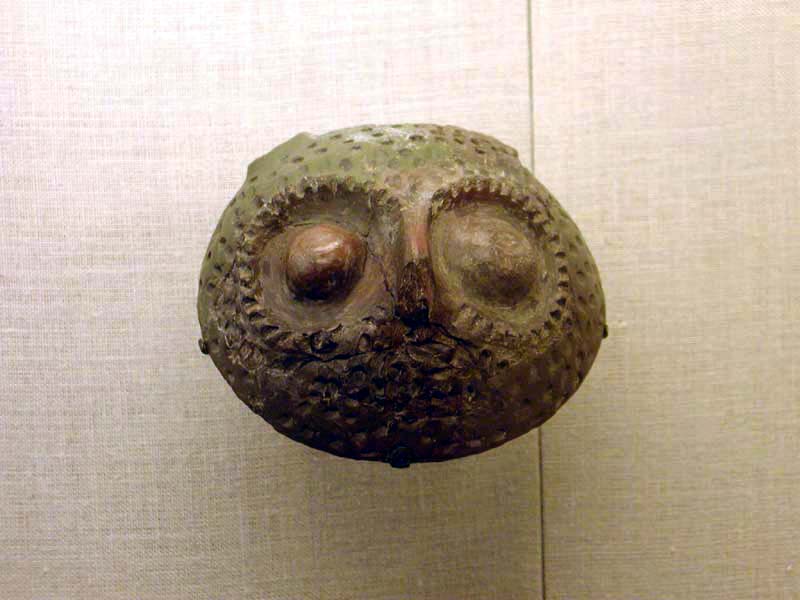|
Shi Chaoyi
Shi Chaoyi (史朝義) (died before 17 February 763Volume 222 of ''Zizhi Tongjian'' recorded that Shi's head reached Chang'an on the ''jiachen'' day of the 1st month of the 1st year of the ''Guangde'' era of Tang Daizong's reign. This date corresponds to 17 Feb 763 on the Gregorian calendar. 广德元年正月)甲辰,朝义首至京师。/ref>) was the final emperor of the Yan state that was established in rebellion against the Chinese Tang Dynasty. He was the oldest son of Shi Siming, and he overthrew and then killed his father in a coup in 761 and took over as emperor. However, he could not gain the allegiance of his father's subordinates, and was eventually defeated by joint forces of Tang and Huige. He committed suicide in flight. Background It is not known when Shi Chaoyi was born, but it is known that he was the oldest son of his father Shi Siming (and therefore likely born after 720), and that he was not the son of Shi Siming's wife Lady Xin. The second historical r ... [...More Info...] [...Related Items...] OR: [Wikipedia] [Google] [Baidu] |
Shǐ (surname)
Shǐ (史) is a Chinese surname meaning "history" of "official historiographer". It is romanized Shih in Wade–Giles, or Sze or Si in Cantonese romanization. According to a 2008 study, it was the 82nd most common name in China. A 2013 study found that it is shared by 2.85 million people, or 0.210% of the population, with the province with the most people being Henan. It is the 63rd name on the ''Hundred Family Surnames'' poem.K. S. Tom. 989(1989). Echoes from Old China: Life, Legends and Lore of the Middle Kingdom. University of Hawaii Press. . Origins # It is said to be borne by descendants of Cang Jie, the official historiographer during the reign of the mythical Huang Di, the ‘Yellow Emperor’The Oxford Dictionary of Family Names in Britain and Ireland # Shi (史), post name of an official in charge of recording historical events during the Western Zhou dynasty. Later, the surname was subsequently adopted as a surname by descendants of official historiographers in many region ... [...More Info...] [...Related Items...] OR: [Wikipedia] [Google] [Baidu] |
Crown Prince
A crown prince or hereditary prince is the heir apparent to the throne in a royal or imperial monarchy. The female form of the title is crown princess, which may refer either to an heiress apparent or, especially in earlier times, to the wife of the person styled crown prince. ''Crown prince'' as a descriptive term has been used throughout history for the prince who is first-in-line to a throne and is expected to succeed (i.e. the heir apparent), barring any unforeseen future event preventing this. In certain monarchies, a more specific substantive title may be accorded and become associated with the position of ''heir apparent'' (e.g. Prince of Wales in the United Kingdom or Prince of Asturias in the Spain, Kingdom of Spain). In these monarchies, the term crown prince may be used less often than the substantive title (or never). Until the late twentieth century, no modern monarchy adopted a system whereby females would be guaranteed to succeed to the throne (i.e. absolute pr ... [...More Info...] [...Related Items...] OR: [Wikipedia] [Google] [Baidu] |
Xue Song
Xue Song () (died 773), formally the Prince of Pingyang (), was a general of the Chinese rebel state Yan, who later submitted to and became a general of Tang Dynasty, from which Yan had rebelled. As was in the case of several other Yan generals who submitted to Tang but who had substantial army and territorial holdings, Xue was allowed to retain his command and territory, semi-independent of the Tang imperial government structure. Background It is not known when Xue Song was born, but he was said to be born in the modern Beijing region. His grandfather Xue Rengui was a well-known general during the reign of Emperor Gaozong of Tang, and his father Xue Chuyu () served as a general as well. Despite Xue Song's coming from a distinguished lineage, it was said that he paid no attention to property management and fell into poverty. It was also said that he was strong and capable in riding and archery, but paid no attention to studies. During the Anshi Rebellion When the genera ... [...More Info...] [...Related Items...] OR: [Wikipedia] [Google] [Baidu] |
Songzhou
Songzhou or Song Prefecture () was a '' zhou'' (prefecture) in imperial China centering on modern Shangqiu, Henan, China. It existed (intermittently) from 596 to 1006. The Song dynasty was named after this prefecture because its founder Emperor Taizu of Song had stationed in Songzhou for many years. Geography The administrative region of Songzhou in the Tang dynasty is in the border area of modern eastern Henan, northern Anhui and southwestern Shandong. It probably includes parts of modern: * Under the administration of Shangqiu, Henan: ** Shangqiu: Liangyuan District and Suiyang District ** Minquan County ** Sui County ** Ningling County ** Zhecheng County ** Yucheng County ** Xiayi County * Under the administration of Heze, Shandong: ** Shan County ** Cao County * Under the administration of Suzhou, Anhui: ** Dangshan County Dangshan County () is a county in the far north of Anhui Province, China. It is under the administration of Suzhou city. It is famous for fruits (p ... [...More Info...] [...Related Items...] OR: [Wikipedia] [Google] [Baidu] |
Shanxi
Shanxi (; ; formerly romanised as Shansi) is a landlocked province of the People's Republic of China and is part of the North China region. The capital and largest city of the province is Taiyuan, while its next most populated prefecture-level cities are Changzhi and Datong. Its one-character abbreviation is "" (), after the state of Jin that existed there during the Spring and Autumn period. The name ''Shanxi'' means "West of the Mountains", a reference to the province's location west of the Taihang Mountains. Shanxi borders Hebei to the east, Henan to the south, Shaanxi to the west and Inner Mongolia to the north. Shanxi's terrain is characterised by a plateau bounded partly by mountain ranges. Shanxi's culture is largely dominated by the ethnic Han majority, who make up over 99% of its population. Jin Chinese is considered by some linguists to be a distinct language from Mandarin and its geographical range covers most of Shanxi. Both Jin and Mandarin are spoken in ... [...More Info...] [...Related Items...] OR: [Wikipedia] [Google] [Baidu] |
Changzhi
Changzhi () is a prefecture-level city in the southeast of Shanxi Province, China, bordering the provinces of Hebei and Henan to the northeast and east, respectively. Historically, the city was one of the 36 administrative areas (see Administrative Divisions of Qin Dynasty) extant under the reign of the first emperor of a unified China (see Qin Shi Huang). Nowadays, Changzhi is a transportation centre in Shanxi. Transportations is facilitated by: four controlled-access highways, (Taiyuan-Changzhi, Changzhi- Jincheng, Changzhi-Linfen, and Changzhi-Handan); two railways, ( Taiyuan–Jiaozuo Railway and Handan–Changzhi Railway ); three national highways, China National Highway 207, 208 and 309; and Changzhi Wangcun Airport ( ITAT Code: CIH, ICAO Code: ZBCZ). Internal transportation also includes a bus and taxi network. The city is a rising commercial and industrial centre in the southeastern area of Shanxi. In 2011, its GDP ranked 1st out of 11 prefecture-level cities in th ... [...More Info...] [...Related Items...] OR: [Wikipedia] [Google] [Baidu] |
An Lushan Rebellion
The An Lushan Rebellion was an uprising against the Tang dynasty of China towards the mid-point of the dynasty (from 755 to 763), with an attempt to replace it with the Yan dynasty. The rebellion was originally led by An Lushan, a general officer of the Tang military system. The event involved military activity and direct deaths from battle, but also significant associated population loss from famine, and population dislocations. The event is also known, especially in Chinese historiography, either as the An–Shi Rebellion or as the An–Shi Disturbances (). The use of the term ''luàn'' ("chaos") indicates the extreme social instability and population loss which eventually resulted, far beyond the initial consequences of the rebellion. Traditionally, Chinese family names have begun with the family name first. In this case the family name of the initial rebel leader is An. The term ''Ān-Shǐ'' is used to recognize that the rebellion continued after An Lushan's death, with ... [...More Info...] [...Related Items...] OR: [Wikipedia] [Google] [Baidu] |
Henan
Henan (; or ; ; alternatively Honan) is a landlocked province of China, in the central part of the country. Henan is often referred to as Zhongyuan or Zhongzhou (), which literally means "central plain" or "midland", although the name is also applied to the entirety of China proper. Henan is a birthplace of Han Chinese civilization, with over 3,200 years of recorded history and remained China's cultural, economic and political center until approximately 1,000 years ago. Henan Province is home to many heritage sites, including the ruins of Shang dynasty capital city Yin and the Shaolin Temple. Four of the Eight Great Ancient Capitals of China, Luoyang, Anyang, Kaifeng and Zhengzhou, are in Henan. The practice of tai chi also began here in Chen Jia Gou Village (Chen style), as did the later Yang and Wu styles. Although the name of the province () means "south of the ellowriver.", approximately a quarter of the province lies north of the Yellow River, also known as th ... [...More Info...] [...Related Items...] OR: [Wikipedia] [Google] [Baidu] |
Sanmenxia
Sanmenxia (; postal: Sanmenhsia) is a prefecture-level city in the west of Henan Province, China. The westernmost prefecture-level city in Henan, Sanmenxia borders Luoyang to the east, Nanyang to the southeast, Shaanxi Province to the west and Shanxi Province to the north. The city lies on the south side of the Yellow River at the point where the river cuts through the Loess Plateau on its way to the North China Plain. As of the 2020 census, it was home to 2,034,872 inhabitants (2,234,018 in 2010). However, as of the 2010 census 947,588 lived in the built-up area made of Hubin, Shanzhou urban districts and Pinglu County in neighboring Shanxi (269,188 inhabitants), now within the agglomeration. Names and History The city's name in Chinese () means "The Gorge of Three Gateways" and is derived from two islands that split the Yellow River into three parts. According to Chinese mythology, Yu the Great used a divine axe to cut the mountain ridge three times, creating the Sanmenxi ... [...More Info...] [...Related Items...] OR: [Wikipedia] [Google] [Baidu] |
Chang'an
Chang'an (; ) is the traditional name of Xi'an. The site had been settled since Neolithic times, during which the Yangshao culture was established in Banpo, in the city's suburbs. Furthermore, in the northern vicinity of modern Xi'an, Qin Shi Huang of the Qin dynasty, China's first emperor, held his imperial court, and constructed his massive mausoleum guarded by the Terracotta Army. From its capital at Xianyang, the Qin dynasty ruled a larger area than either of the preceding dynasties. The imperial city of Chang'an during the Han dynasty was located northwest of today's Xi'an. During the Tang dynasty, the area that came to be known as Chang'an included the area inside the Ming Xi'an fortification, plus some small areas to its east and west, and a substantial part of its southern suburbs. Thus, Tang Chang'an was eight times the size of the Ming Xi'an, which was reconstructed upon the site of the former imperial quarters of the Sui and Tang city. During its heyday, Chang ... [...More Info...] [...Related Items...] OR: [Wikipedia] [Google] [Baidu] |
Luoyang
Luoyang is a city located in the confluence area of Luo River (Henan), Luo River and Yellow River in the west of Henan province. Governed as a prefecture-level city, it borders the provincial capital of Zhengzhou to the east, Pingdingshan to the southeast, Nanyang, Henan, Nanyang to the south, Sanmenxia to the west, Jiyuan to the north, and Jiaozuo to the northeast. As of December 31, 2018, Luoyang had a population of 6,888,500 inhabitants with 2,751,400 people living in the built-up (or metro) area made of the city's five out of six urban districts (except the Jili District not continuously urbanized) and Yanshi District, now being conurbated. Situated on the Central Plain (China), central plain of China, Luoyang is among the List of oldest continuously inhabited cities#East Asia, oldest cities in China and one of the History of China#Ancient China, cradles of Chinese civilization. It is the earliest of the Historical capitals of China, Four Great Ancient Capitals of China. Name ... [...More Info...] [...Related Items...] OR: [Wikipedia] [Google] [Baidu] |

.png)






